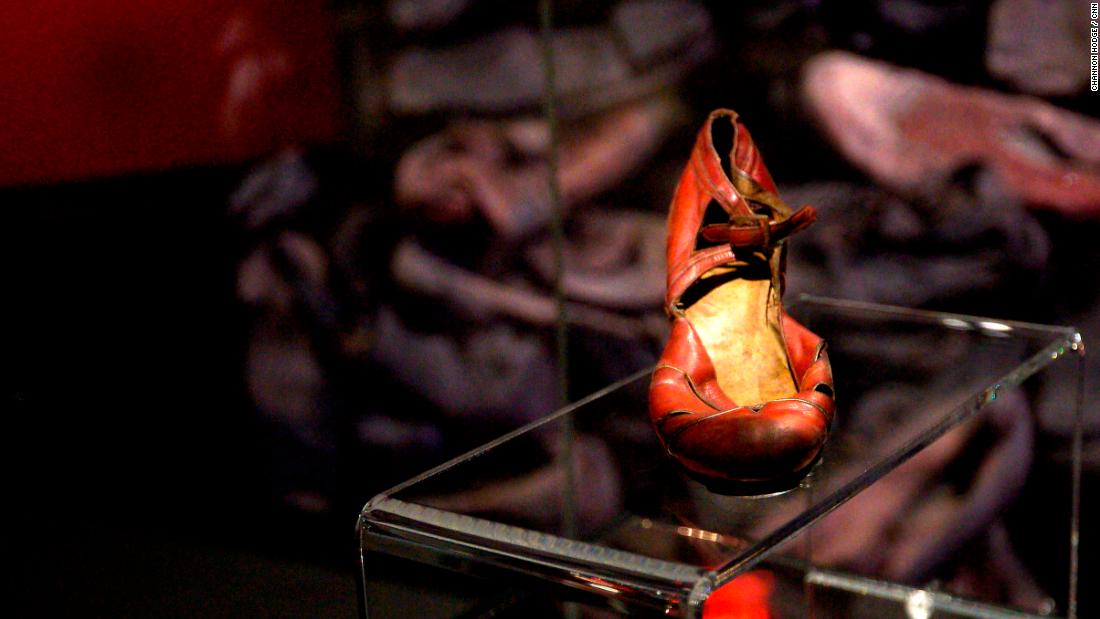New York City (CNN) — There’s a toddler’s blush pink, ruffled dress. A buckled red shoe with cut-out slits. Clear and sea foam colored liquor bottles.
The exhibition was originally scheduled to end in January, but after receiving more than 100,000 visitors, it was extended through August 2020.
“The woman that owned that shoe, unfortunately, we don’t know anything about her,” said one of the exhibition’s directors, Luis Ferreiro. “Those objects are the only thing that have survived a human being. Everything else is literally ashes in the wind.”
More than 20,000 of the exhibition’s visitors have been New York public school students who came in groups to see the stories behind those objects and hear directly from survivors.
The department will also work closely with some area schools to send eighth and tenth grade classes on field trips to the museum. Officials said they hope the exhibition’s lessons from the past have reverberating effects for the present.
“We have seen a startling increase in swastika vandalism in New York City, which has contributed to the high number of anti-Semitic hate crimes,” said Deborah Lauter, executive director of the New York City Office of Hate Crimes. “By studying the Holocaust, students learn about the meaning of this symbol and where stereotypes, prejudice, and discrimination can lead.”
Battling hate
The exhibition’s artifacts, videos and stories explain how anti-Semitic sentiment led to the murder of millions of Jews by the Nazis. Researchers estimate around 1 million Jews were murdered at Auschwitz alone, along with over 100,000 Poles, Russian soldiers, Roma, LGBTQ people, political dissidents and anyone deemed “undesirable” by the Nazis.
“Auschwitz became a place where all this life and all these stories were converging and most of them were being taken away from earth,” said Ferreiro. “And now it’s the opposite.”
Ferreiro is director of Musealia, a family company known for the wildly successful “Bodies… the Exhibition.”
In 2013, Ferreiro reached out to Holocaust expert Robert Jan van Pelt to convince him to work together to tell the story of Auschwitz in a traveling exhibition. Their team came together in partnership with the Auschwitz-Birkenau State Museum to bring the story behind Auschwitz to audiences who may never visit the concentration camp in Poland. They intended to bring new focus to the Holocaust — to death, yes, but also to life.
When van Pelt first started working with Ferreiro, he said he’d thought the lesson of Auschwitz was indelible. He learned he was wrong.
“Nazism was a society in which the distinction between truth and falsehood had ceased to be important,” said van Pelt. “We’re back in a situation that Joseph Goebbels and Adolf Hitler and [Hermann] Göring and Heinrich [Himmler] would recognize as being their own.”
Glass bottles

The Haberfeld factory in Oświęcim, Poland, had been in operation since 1804 and the owners were part of a vibrant Jewish community full of schools and several synagogues.
David Varillas / Musealia
Sharing the story of Auschwitz outside of the Auschwitz-Birkenau State Museum in Poland has freed curators to reconfigure the telling.
The three-floor exhibition leads visitors through the history of the Jews in Europe, through the series of cultural developments that made Auschwitz possible, and then lays out the atmosphere of the camp itself.
“You cannot simply begin in 1940, when Auschwitz was created,” said van Pelt. “Auschwitz was created on the history of racism, the history of hate, on the history of imperial policy making.”
They borrowed and reconstructed part of the barracks straight from Auschwitz-Birkenau and put a massive freight car from the time period outside the exhibition doors.
German SS Commandant Rudolf Höss’s desk is here, along with photos of his wife looking on as his children played in the gardens built inside the first and smaller camp in Auschwitz. Many of these objects are being seen outside of Poland for the first time, while others were borrowed from a dozen museums around the world.
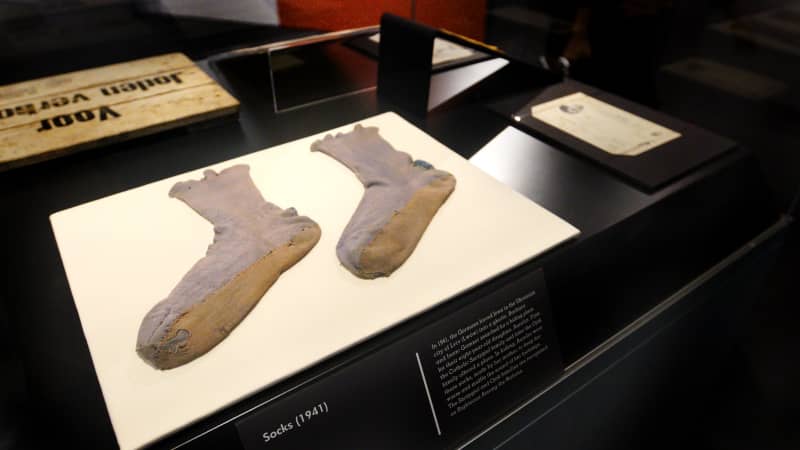
Barbara Gamzer sewed padding onto the bottom of these socks to muffle her child’s footsteps while in hiding.
Channon Hodge / CNN
The objects which stir the most feeling, however, are the ones that are seemingly benign: buttons and shirts, shoes and socks, bottles.
One can imagine how the vodka bottles smelled when they were filled with liquor at the Jacób Haberfeld factory in Oświęcim, a town which would eventually be the site of the first of a group of concentration camps now known as Auschwitz.
The bottles sit with remnants of a town synagogue and other objects that tell the story of a town whose population was, at one point, 50% Jewish.
Alfons and Felicia Haberfeld were members of a long-established Jewish family, whose liquor business and factory had been operating for over 100 years. The couple decided to expand on its success by bringing samples to the 1939 World’s Fair in New York City.
They would learn later that their home had been confiscated by the German government. Their daughter, her grandmother and the rest of the family went into hiding, but were eventually discovered by the Nazis. It wasn’t long before they were sent to a concentration camp and murdered shortly after arrival.
A Pink dress
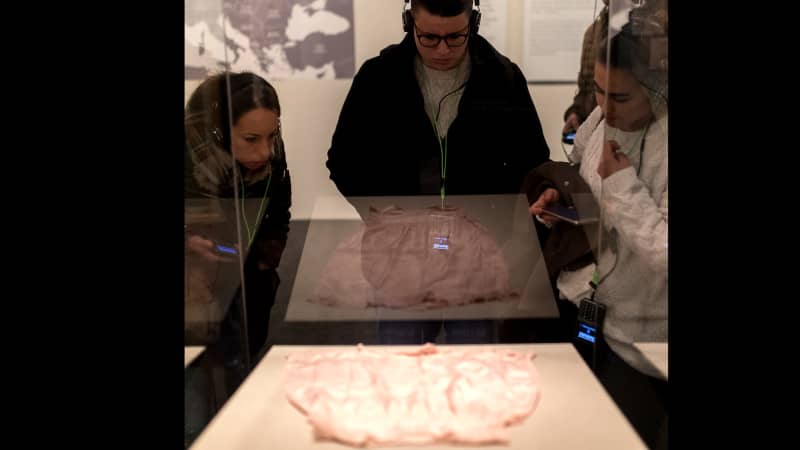
This dress belonged to a Jewish toddler named Gaby Klipper who lived with her family in Vienna in the 1930s. According to Vienna’s Museum of the Jewish people, there were over 160,000 Jewish people living in the city before the war began. The population numbered around 4,000 at the war’s end.
David Varillas / Musealia
The once peaceful town of Oświęcim was one of many cities that the Nazis annexed and then “Germanized” throughout Poland. The Jews who lived there were rounded up, sent to ghettos and many later deported to concentration camps.
The exhibition explains how the Germans’ first concentration camp in Oświęcim was intended to strike fear in dissenting Poles using Polish political prisoners, Russian soldiers and other outcasts as laborers.
The Germans also abandoned plans to use captured soldiers and prisoners as laborers and turned instead to their most hated group — the Jews. There were tens of thousands of able-bodied Jewish workers living in the nearby Slovak republic. At first, the Germans wanted to import only these able-bodied Jews, leaving the young, old and sick behind. The Slovak government told its ally, Germany, that they had to take them all.
“So, in a sense, the Holocaust, the murder of six million Jews enters Auschwitz through the back door,” van Pelt said as he told the story laid out in the exhibit. “It wasn’t that Birkenau was planned with that goal, but it was because one group of potential slave workers was not available anymore. They identified the Jews as a convenient replacement for the Soviet POWs, but they needed to solve, quote-unquote, the problem of the Jews who couldn’t work. So, that’s how murder begins.”
The Germans decided to take all of the Slovak Republic’s Jews and kill the ones who couldn’t work upon arrival. The decision was a seed that grew and grew. As Hitler’s “Final Solution” took shape across German territory, Auschwitz grew more complex, gas chambers and crematoriums were built, and by 1943, over 300,000 Jews from all around Europe had been murdered there.
On September 6, 1943 that number included the owner of a blush-pink, ruffled dress and the family of Jacob Klipper.
Klipper left his family in Vienna in 1939 when the persecution of Jews was pervasive throughout Europe. He’d taken trunks of his family’s possessions, including his daughter’s pink dress, and traveled to what was then Palestine to prepare for his family to join him there, even though the country was nearly closed to Jewish immigration.
The Jewish people were once allowed in numbers to emigrate to other countries including the US. Van Pelt and numerous other reports say many had all but closed their doors in the mid 1930s.
“The world is protesting, but Hitler says nobody wants to take them,” said van Pelt, referencing a famous January 1939 speech by Hitler, part of which can be heard at the exhibition. “If you’re the friend of the Jews, if you think that the Jews have a rough deal, please open your doors, take them. I’m happy to give you our Jews.”
“And in some way, in a perverse way, he was right,” said van Pelt. “The world was not willing to, basically, accept Jewish refugees. For Hitler, that’s also a kind of an indication that he can do with, quote-unquote, his Jews what he wants. That the world doesn’t care.”
The final blow to Jewish emigration came when the US entered the war in 1941. World War II kept Klipper from being able to move his family out of Vienna, or to return to them before they were sent to Auschwitz in 1943, where they were murdered.
A red shoe
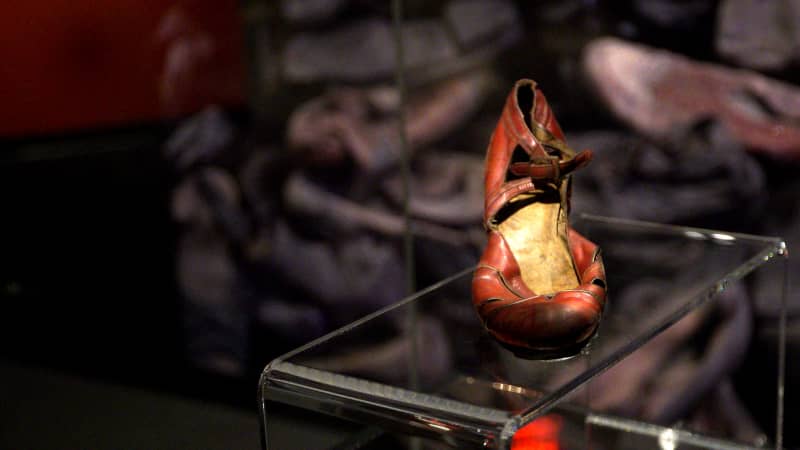
The owner of these shoes, like many of the objects found at Auschwitz-Birkenau, may never be identified because large numbers of records and files were destroyed by SS soldiers as they abandoned the camp.
Channon Hodge / CNN
The red shoe is in the very first large room in the exhibition. It’s in a glass case all by itself under a spotlight. It’s opposite a piece of a wall and barbed wire straight from the camp.
“Those shoes … we’ve explained them, in a way, a simple form,” said Luis Ferreiro. “Because we believe each one of them is a fragment of history and has its own echo – its own voice.”
There is radio silence around this shoe, and it’s eerily quiet in all the other rooms. A class full of young, mostly African American high school students walk around with a tour guide. They don’t pull out cell phones. They don’t joke around.
The visitors that do speak, speak softly. There is the father who pulls his children close to explain more about a map of Jewish populations in Europe pre-Holocaust.
One woman asks the young man with her if he also has a tallit at home. She saw the sacred shawl given to boys at their bar mitzvah explained in a glass case in the exhibition. That’s normally something you wouldn’t see after a man has died, he tells her. A tallit stays with a man his whole life and should be buried with him, he says, so it’s significant that the owner of the tallit in the exhibition sent his away to his family, knowing he might never see them again.
Another woman visiting the exhibition shares with a stranger that she is simply overwhelmed by the charts and the maps and the books and the publications that the Nazis used to justify their war against the Jews. The complexity of the lies is what has surprised her most. She regretted coming alone, as it was all so overwhelming.
Many may avoid coming to this exhibition, fearing the same, but the woman says she is glad she came after all. The exhibition has made her realize something. She sees that the Jewish people will always be here. She says they will survive despite all.
Missing Objects
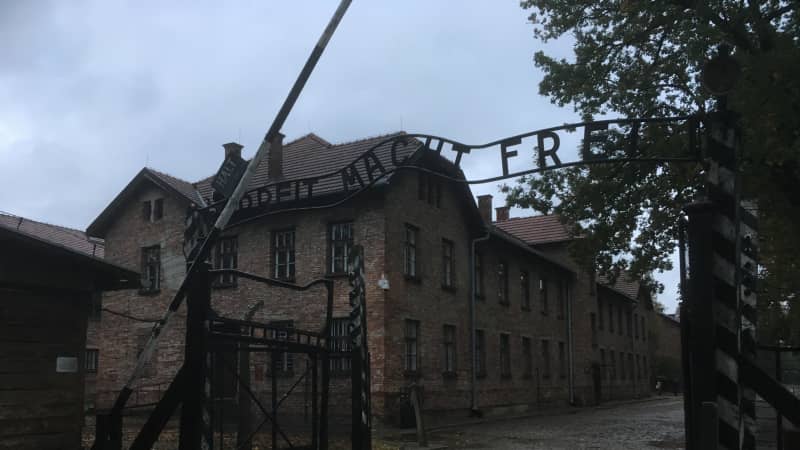
The entrance to the gate in the first Auschwitz camp reads Arbeit macht frei, “work sets you free.”
Iciar Palacios / Musealia
Holocaust survivor Bronia Brandman lived through Auschwitz even though she entered at age 11. Few Jewish children survived there for long.
“I was very impressed with the exhibit,” said Brandman, who visited the exhibit along with other survivors before it opened to the public.
She’s 88 years old now, but most survivors are older or have passed on. Her story is not in the museum, nor are there pieces and details for many of the others who died in the camps without identification or records or family members to remember them.
She was only 11 years old when she and her three sisters stepped off the train at Auschwitz in August 1943. She and her younger sisters, Rutka and Macia, were immediately ordered to go left. At an undetected moment, Brandman ran to the right towards her older sister Mila who was destined for labor.
She said she knew that leaving her younger sisters meant she was leaving them to die alone in the gas chamber.
She survived for nearly a year and half in the barracks, through sickness, through Mila’s death in the same gas chambers and through the death march. She was liberated by American and Russian troops in 1945. Later, she became a teacher and now lives in New York City.
She says the exhibition doesn’t convey the true horror of the camps. It can’t, she says. Still she asks people to visit the museum and to not rush through. It can take at least three hours to see the entire exhibition, although you can easily spend more. She hopes, in some way, it does something to battle the Holocaust deniers and the ones that have simply forgotten its importance.
“And you know 41% of the population never heard of this?” Brandman asked.
“I never, not for a minute, forget my siblings, never forget the horror inflicted on us,” said Brandman. “And the people don’t even know? I’m still alive, and the people don’t know?”
